LONDON SURVIVES OVERNIGHT AIR RAID
London, England · December 29, 1940
On this date in 1940, when President Franklin D. Roosevelt appealed to the nation in a radio “fireside chat” to support his proposal to strengthen the U.S. military in light of developments in Europe, the German Luftwaffe delivered a massive attack on the British capital, London. Almost 3,000 civilians were killed in the overnight bombing. The attack was part of the Luftwaffe’s sustained strategic bombing campaign of Great Britain and Northern Ireland, which the British public dubbed the Blitz (September 7, 1940, to May 10, 1941). The Blitz (German, “lightning”) was Adolf Hitler’s punishment for Britain’s refusal to surrender their island to him during the Battle of Britain. For 57 nights straight, 200 or more German bombers dropped high-explosive and incendiary bombs on London, targeting the “Square Mile,” the heart of the capital. Across the country many civilian and industrial targets faced similar onslaughts—Liverpool, Cardiff, Bristol, Manchester, Belfast, Coventry, and Glasgow to name a few. More than one million London residences were destroyed or damaged, and more than 40,000 civilians were killed, almost half of them in London alone. During these bleak eight months of the Blitz Great Britain stood alone and defiant. The United States would not enter the war on the side of Britain until December 1941, a year away. The Blitz never achieved its intended goals of either demoralizing British political and military leaders into capitulation or significantly damaging the country’s economy to continue the war. Roosevelt’s December 29 appeal, memorable for its line that the U.S. must become the “arsenal of democracy” for the nations standing up to Nazi Germany, Fascist Italy, and Imperial Japan, was realized in the Lend-Lease Program, which kicked off in March 1941. The first delivery of supplies reached the beleaguered British Isles mid-year. (Food was the largest single category in 1941.) By the time the last of the Luftwaffe’s bombs had fallen on London on May 10, 1941, in a particularly savage climax to the Blitz (507 aircraft dropped 711 tons of bombs, killing or wounding more than 3,000 people), the threatened cross-channel invasion of England (Operation Sea Lion) had passed. Hitler’s attention now turned to the Soviet Union (Operation Barbarossa), a mistake with grievous consequences.
[amazon_carousel widget_type=”ASINList” width=”600″ height=”200″ title=”Recommended Reading” market_place=”US” shuffle_products=”False” show_border=”False” asin=”0300125569,0151014043,1907176713,0679432981,0859791483,1400067588,030435676X,0947554823,0091910048,0752450158″ /]
The Blitz, Germany’s Strategic Bombing of Great Britain, September 7, 1940, to May 10, 1941
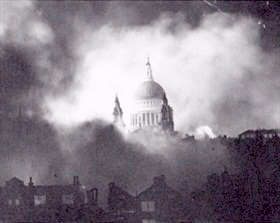 | 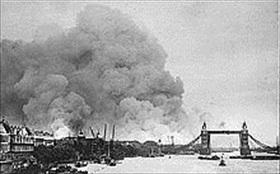 |
Left: London’s St Paul’s Cathedral, undamaged, ringed by clouds of smoke in this iconic photograph taken on December 29, 1940. The cathedral was struck four times during the Blitz: in September, October, and December 1940 and in April 1941.
![]()
Right: Surrey docks in flames on the Thames in Southeast London, September 7, 1940, start date of the Blitz. During the course of the Blitz, over 100,000 tons of shipping were damaged in the Thames Estuary, 800 civilians were injured, and 400 civilians were killed.
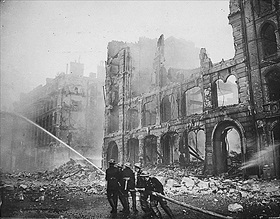 | 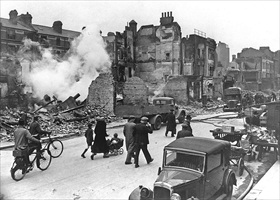 |
Left: Firefighters put out a blaze in London after an air raid during the Blitz in 1941. Less than halfway into the 37 weeks of the Blitz, the Luftwaffe had dropped more than 13,000 tons of high explosives and nearly 1,000,000 incendiaries on London.
![]()
Right: A street of ruined houses in London. More than one million London houses were destroyed or damaged and close to 20,000 Londoners killed during the 267 days of the Blitz. By contrast the Allied bombing raid on the large North German port and industrial center of Hamburg during the last week of July 1943 (Operation Gomorrah) killed 42,600 civilians, wounded 37,000, and practically leveled the city in a series of one-two punches, first by high explosives and then incendiaries. Local rescue efforts stalled after British bombers cut electricity to a major portion of the city for two weeks.
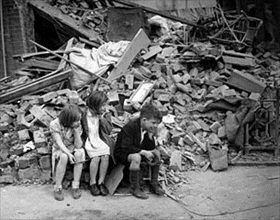 | 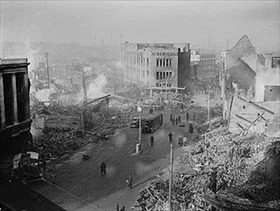 |
Left: Children of an eastern suburb of London made homeless by the Blitz. Though militarily ineffective, the Blitz caused enormous damage to Britain’s infrastructure and housing stock.
![]()
Right: Coventry city center after 449 German bombers had dropped 530 tons of bombs on the night of November 14/15, 1940. With poor anti-aircraft defenses for a city with many wartime industries, Coventry was smashed: 75 percent of all buildings, 33 percent of all factories, and 50 percent of all homes were destroyed by a combination of German high-explosive bombs and incendiaries.
Amateur Color Film of Destruction Caused by London Blitz, 1941 (Suggest silencing the projector’s sound)
![]()

 History buffs, there is good news! The Daily Chronicles of World War II is now available as an ebook for $4.99 on Amazon.com. Containing a year’s worth of dated entries from this website, the ebook brings the story of this tumultuous era to life in a compelling, authoritative, and succinct manner. Featuring inventive navigation aids, the ebook enables readers to instantly move forward or backward by month and date to different dated entries. Simple and elegant! Click
History buffs, there is good news! The Daily Chronicles of World War II is now available as an ebook for $4.99 on Amazon.com. Containing a year’s worth of dated entries from this website, the ebook brings the story of this tumultuous era to life in a compelling, authoritative, and succinct manner. Featuring inventive navigation aids, the ebook enables readers to instantly move forward or backward by month and date to different dated entries. Simple and elegant! Click 











